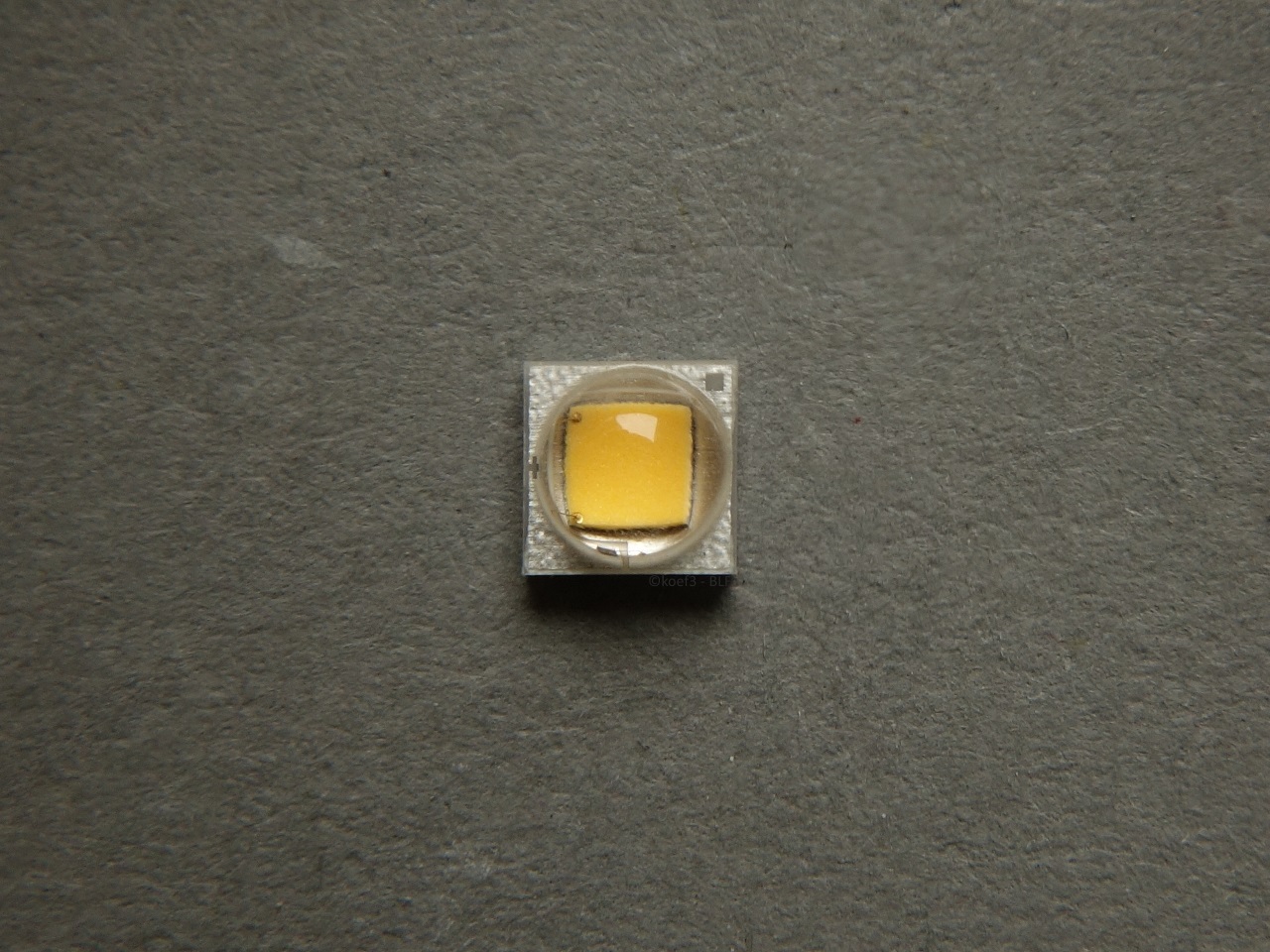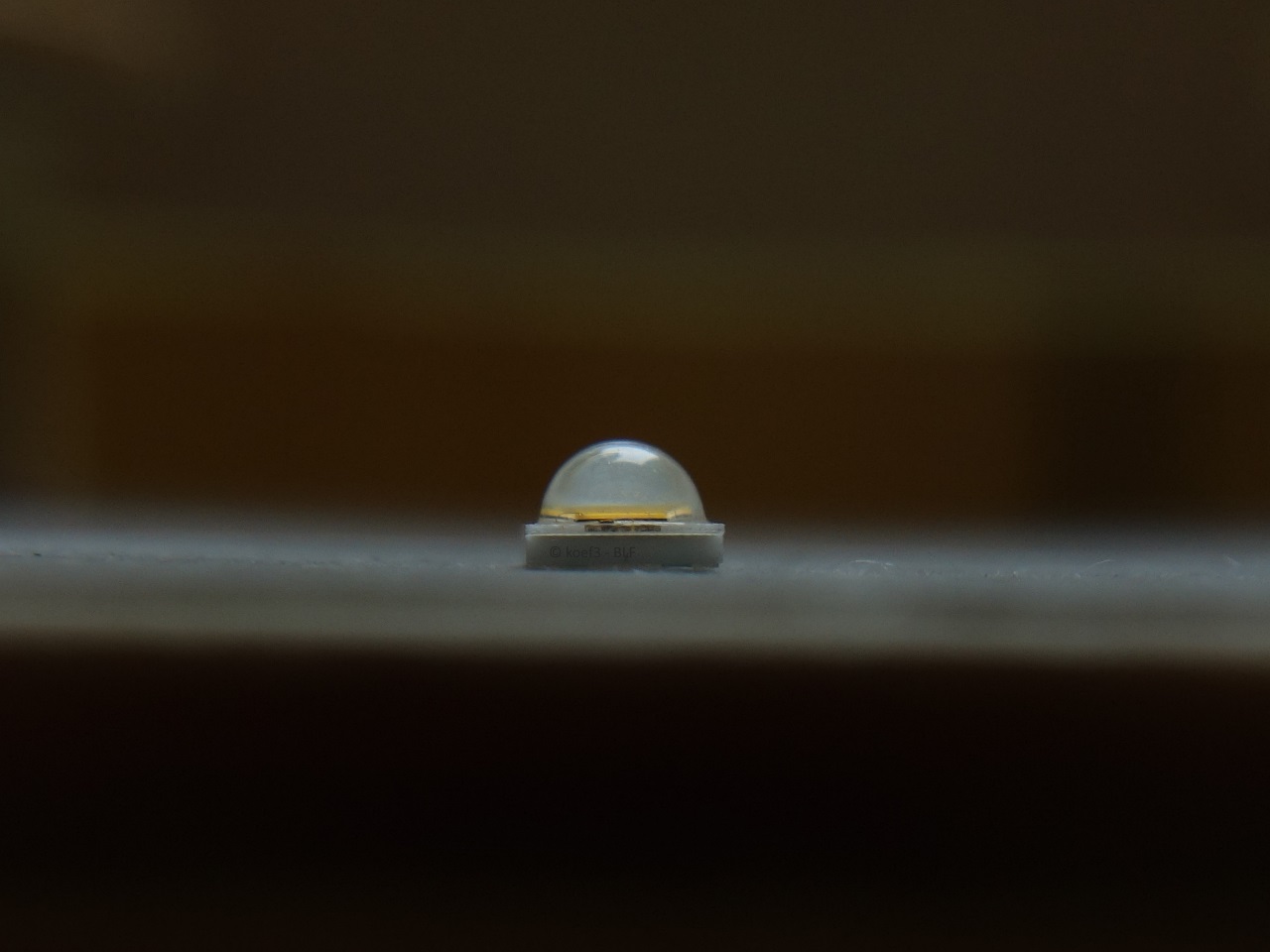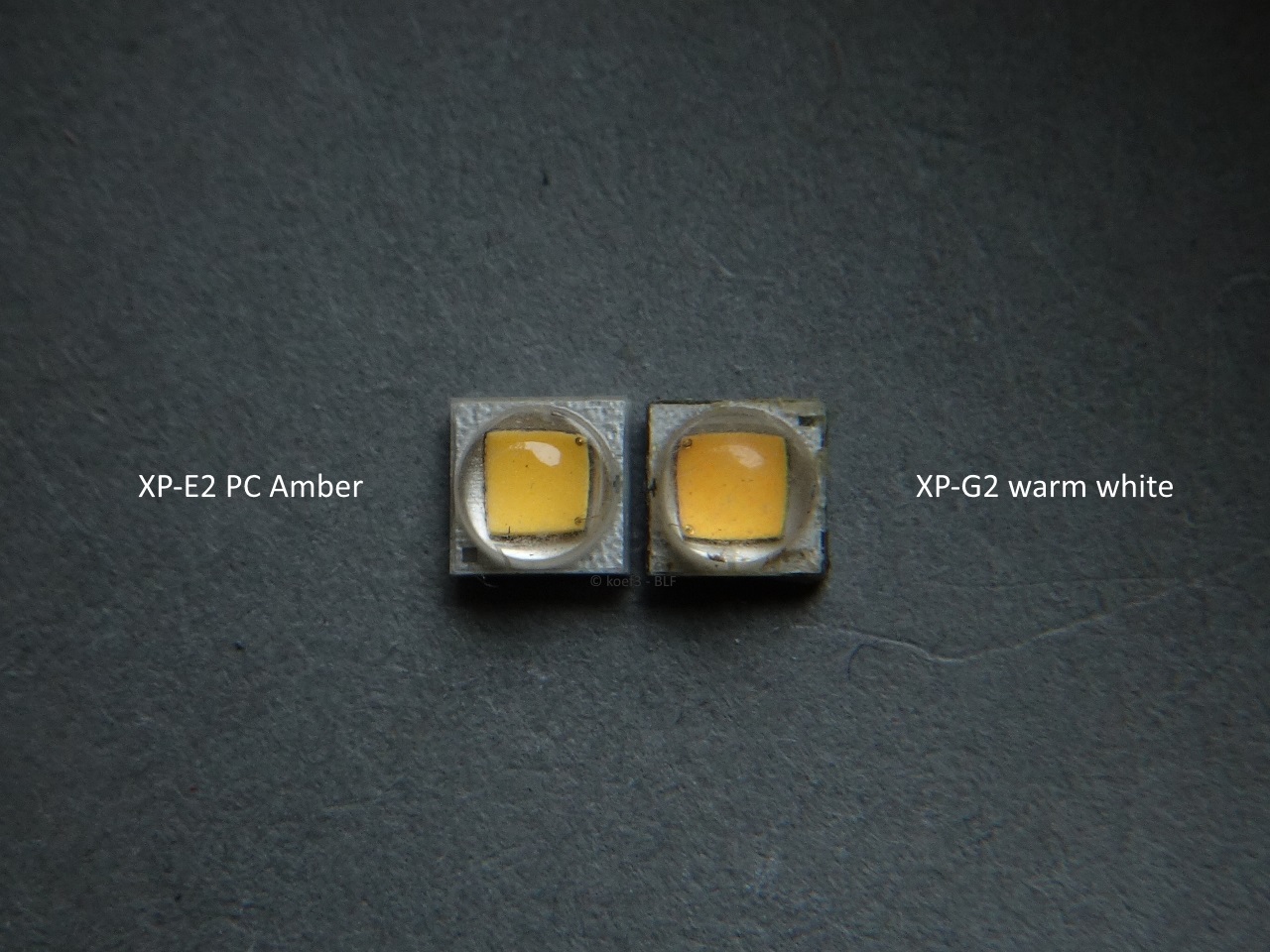LED test / review
EN
Cree XLamp XP-E2 PC Amber
XPEBPA-L1-0000-00C01

LEDs are now available in many different color temperatures. They range from very warm white to extreme blue. As a rule, the blue and red components mostly in the visible spectrum determine the "temperature of the light". This is given in Kelvin, based on the spectrum of a thermal radiator, what we commonly know as an ordinary incandescent lamp or the sun.
Commercially available LEDs come in color temperatures (CCT) from 2700 to 6500 K, with cool white emitters used mostly in flashlights and warm white emitters used more in residential lamps. Some LED models are available with 2400 or 2200 K CCT, but - it goes even warmer!
The LED tested here is of the PC Amber type, which means "phosphor converted amber". This basically describes the way the yellow-orange light is produced, with a special phosphor mixture on the die, which is however strongly based on the phosphor mixtures of warm white LEDs. (Classic color LEDs use an entirely different coating on the light-emitting surface). This type of light is primarily used as an environmentally friendly replacement for low-pressure sodium lamps.
Technical data
Tj 25 °C, If 350 mA
Order code: XPEBPA-L1-0000-00C01
Type: single die
Flux bin: Q4, typ. 100 lm
Color group: Y2
Rated voltage: typ. 3.05 V max. 3.50 V
Forward current: max. 1,000 mA
Peak current: 1,000 mA
Viewing angle: typ. 110°
Thermal resistance: typ. 9 °C/W
Max. Temperatur Tj: max. 150 °C
First appearance
The XP-E2 PC Amber looks very similar to a warm white XP-G2. The substrate is gray or dark gray and is covered by a transparent silicone dome. Inside it is the orange luminous surface.
The black square in the upper right corner marks the cathode, a small plus on the left side - right next to the bonding wires - marks the anode.
Due to the dimensions of 3.45 x 3.45 mm, this LED is classified as the XP footprint, which has also become a de facto-standard with other manufacturers such as Luminus or Nichia. This means that it is usually easy to replace the LED manufacturer without having to change the complete PCB design, an aspect that is becoming increasingly important in today's world.



There are no deviations in the outer dimensions of the LED tested here (purchase date: early 2017) compared to an XP-E2.
LED chip and die
The luminous surface is also very similar to the classic XP-E2/-G2. The only noticeable thing here compared to the XP-E2 is the larger layer of phosphor, which really "glows" at low currents, almost like a hot chunk of metal. There are no visible dots or artifacts.

The light area with dome is 3.23 mm² in size, which is why this LED has more similarities of the XP-G2.

In the past, bonding wires at the outer corners werecommon, but today it is rather conspicuous. This type of construction is nowadays becoming less and less important, as it reduces efficiency by covering the luminous surface. Many LEDs are now manufactured in flip chip design, in which contacting takes place on the underside from the substrate. Nevertheless, there are some a well-known manufacturers like Luminus, which still produces highly efficient LEDs in this traditional design.
Power and overcurrent capabilities
Tsp 25 °C unless otherwise noted

Within official parameters:
- at 1,000 mA (rated max current): 228 lm @ 3.27 V
- Power at rated maximum: 3.27 W
- Efficiacy at 1,000 mA: 69.7 lm/W
- At 350 mA (Binning conditions, 25 °C Tj): 99 lm @ 3.01 V – corrected to 85 °C acc. to Cree datasheet and PCT: 82 lm
The XP-E2 PC Amber tested here meets the specified binning (100 lm @ 25 °C/350 mA), since Cree guarantees a tolerance of +/- 7% for the luminous flux binning. So according to my measurements, this LED actually corresponds to Bin Q4.
Overcurrent:
- Maximum at 3.90 A, at this point 430 lm @ 3.90 V
- Power at maximum 15.2 W
- Sweet Spot at approx. 2,200 mA (367 lm @ 3.57 V)
- Power at Sweet Spot 7.9 W
- Efficiacy at maximum 28.3 lm/W
- Efficiacy at Sweet Spot 46.7 lm/W
Due to the special design similar to warm white LEDs, the efficiency is not high. At maximum possible current this LED is even less efficient than a halogen lamp at strong overcurrent!
Light quality and use in optics

Due to the homogeneous light area and the lack of colored areas around the die, there are no problems when using secondary optics. In the picture, the XP-E2 PC Amber was installed in a small SK68-based zoom lamp with diffuser.
Interestingly, there is minimal blue despite the extremely warm light color. Although the color blue is generally almost completely swallowed and appears almost black, a faint blue glow can be made out in intense blue tones. Green and red are visibly reproduced.
This is pretty much the spectrum that Cree specifies in its spec sheet, and is also very similar to the spectrum of a low-pressure sodium lamp. This is achieved by using phosphor technology similar to that of classic warm white LEDs.
Conclusion
Sodium-vapor lamps are primarily used for area illumination, so the practical suitability of these equivalent LEDs is likely to remain relatively low.
The use of secondary optics - reflectors as well as lenses - is possible without any problems, it can be used freely without design changes due to the XP footprint, and it delivers similar overcurrent performance as the XP-E2 in its classic form due to the quasi identical thermal resistance.
For flashlights, I really only see one application, and that is as a candlelight replacement, in conjunction with a diffuser. However, this LED is surprisingly effective as a candlelight substitute, especially with weak luminous fluxes, although this is always subjective and does not allow any conclusions to be drawn about the general public.
Pro:
- extremely warm tint
- good beam pattern in conjunction with optics
- Freely interchangeable thanks to XP footprint
Contra:
- almost no blue in the spectrum
- Very low efficiency due to design
Thanks a lot for reading! :)
Greetings, Dominik (aka BLF member koef3)